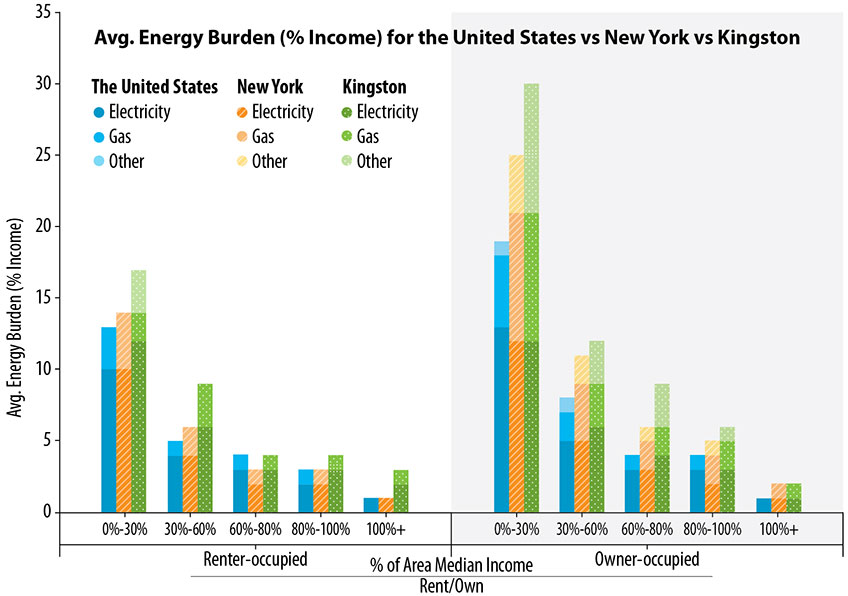NREL Analysis Informs Equitable Clean Energy Transitions in Kingston, New York
Aug. 6, 2020
To help the city of Kingston, New York, achieve its clean energy goal, NREL analyzed its low-income energy affordability, energy efficiency opportunities, and local economic impact.
In 2017, Kingston committed to achieving 100% clean energy by 2050 with a focus on equity and energy efficiency. City officials outlined the following three priorities in achieving the clean energy goal:
- Increasing energy efficiency and renewable energy while decreasing energy bills for low-income residents
- Increasing practical local investment
- Increasing community jobs.
Low-Income Energy Affordability
The city's focus on equity led to an exploration of energy burden. To do so, NREL used the Low-Income Energy Affordability Data (LEAD) Tool. The online tool—developed by NREL and funded by the U.S. Department of Energy (DOE)—help stakeholders improve their understanding of household energy characteristics.
What Is Energy Burden?
The percentage of household income spent on energy expenses (electricity and home fuels). Generally, a household energy burden over 6% is considered unaffordable. Energy burden does not account for the households that are going without essential energy services (by actively choosing to go without or by lack of access).
Kingston has a higher energy burden among low-income households as compared to state or national averages. In the city, 43% of households spend more than 9% of their annual income on utility bills according to the LEAD Tool. Figure 1 illustrates that Kingston has an average higher energy burden across all levels of Area Median Income (AMI) than New York state or the United States. Owner-occupied households earning 0% to 30% of AMI (about 400 households) spent an average of 31% of income on utility bills in Kingston. Approximately 1,470 renter-occupied households in this same income category spent an average of 17% of annual income on utility bills.

Energy Efficiency Opportunities
NREL provided detailed analysis of a cohort of buildings to determine how energy efficiency measures could be best implemented to meet the city’s clean energy and equity goals. Energy efficiency analyses of residential, commercial, and city buildings demonstrated high energy and cost savings potential in the city's mostly older building stock.
Kingston City Land Bank is a not-for-profit organization that works to transform vacant or distressed properties. Part of the NREL study examined the potential impacts of energy efficiency investments in 15 vacant and condemned Land Bank buildings planned to undergo extensive renovations and to be used for affordable housing. NREL experts identified cost-optimal efficiency packages with the Building Energy Optimization Tool (BEopt) software. NREL determined that an approximately $46,000 investment per building (based on a new construction scenario with all new appliances and HVAC systems) could yield 62% average energy savings per building, which equates to $2,400 average annual energy bill savings per residence. In addition, the investments can lead to improved indoor air quality, comfort, and safety. Up-front investment will lead to lower costs over the long term for low-income residents.
Analysis indicated that mini-split heat pumps increase efficiency and lower energy bills. For the 15 Land Bank buildings, replacing boilers/furnaces and air conditioning units with mini-split heat pumps for heating and cooling reduced per building energy consumption by an average of 50%. Ductless mini-split heat pumps avoid energy losses associated with the ductwork of central forced air systems. According to DOE's Energy Saver website, duct losses can account for more than 30% of energy consumption for space conditioning.
NREL also analyzed 11 city-owned buildings and found that investing $586,000 in energy efficiency measures (e.g. lighting, heat pumps, and control systems) would save the city approximately $85,000 annually in energy costs.
Local Economic Impact
In addition to savings resulting from energy efficiency improvements, the analysis considered job creation. The job creation analysis was informed by the BEopt analysis, and the employment multiplier approach, which assumes that every million-dollar investment in energy efficiency in 2019 yields approximately 5.5 direct jobs and 10.9 indirect jobs according to the Economic Policy Institute. This analysis is consistent with job development estimates completed using BEopt and a project labor percentages approach. A project labor percentages approach accounts for the local labor market and the percentage of project costs represented by labor expenditures. NREL assumed that 40%–70% of total project costs were spent on labor.
These two approaches determined that approximately 20, one-year, full-time-equivalent jobs could be developed in the community by pursuing the efficiency opportunities for the 24 Land Bank and city buildings. In addition, 120–470, one-year, full-time-equivalent jobs could be developed by implementing rooftop solar and efficiency projects in the Midtown district of Kingston.
Read the Full Report
Equitable Clean Energy Transitions for Small Communities: NREL Supports Kingston, New York, in Building a Community-First Approach to 100% Renewable Energy
READ REPORTNREL Technical Support Services
NREL is providing world-class energy analysis and technical assistance to help local and state jurisdictions across the country and the world meet their energy goals. To learn more, see NREL’s Technical Support Services.
Share

